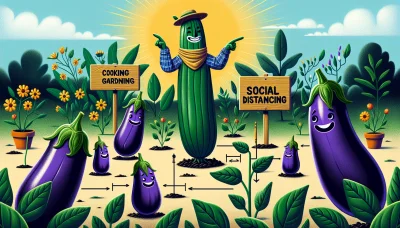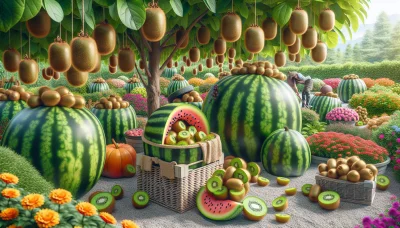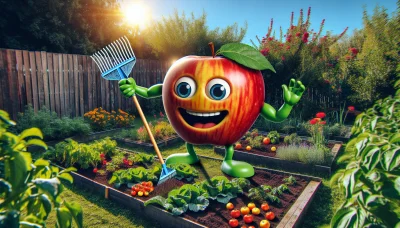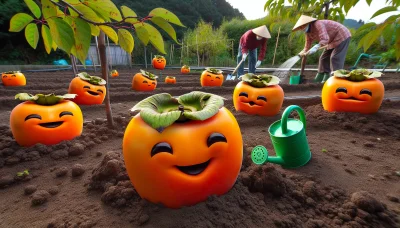Ripe persimmon Quiz
Test Your Knowledge
Question of
Understanding Ripe Persimmons
Persimmons are a type of fruit that originate from Asia, particularly China, before spreading to other parts of the world such as Japan, Korea, and the Mediterranean. There are many varieties, but the two most commonly found are the Hachiya and the Fuyu. Persimmons are unique in their taste and texture, which can range from sweet and succulent when ripe to astringent and chalky if eaten before maturity. Identifying when a persimmon is ripe is crucial to enjoying its full flavor. For Hachiya persimmons, they should be incredibly soft to the touch, almost to the point of bursting. This variety is best enjoyed when it feels like a water balloon. On the other hand, Fuyu persimmons are ready to eat when they have a bit of give to them, similar to a ripe tomato, and can be eaten like an apple. The color of ripe persimmons can range from a deep orange to a reddish hue, but the key indicator is the texture. By understanding these characteristics, you can ensure that you enjoy persimmons at their peak of ripeness.
The Benefits of Growing Persimmons
Gardeners should consider growing persimmons in their gardens for a multitude of reasons. Firstly, persimmon trees are not only productive but also add aesthetic value with their beautiful foliage and striking fruit. They are relatively low-maintenance, requiring minimal care once established, and are resilient to many pests and diseases. Furthermore, the fruit itself is highly nutritious, offering a rich source of vitamins, minerals, and fiber. Persimmons can be consumed fresh, dried, or used in various culinary dishes, making them a versatile addition to the garden. Additionally, these trees can adapt to a wide range of climates, ensuring that many gardeners can enjoy their benefits regardless of their location.
Choosing the Right Persimmon Variety for Your Garden
- Fuyu (Jiro) - Non-astringent, crunchy when ripe.
- Hachiya - Astringent, must be fully ripe and soft before eating.
- Chocolate - Astringent, known for its brown flesh when ripe.
- Tanenashi - Astringent, conical shape, and seedless when not cross-pollinated.
- Maru (Cinnamon) - Non-astringent when pollinated, known for its spicy flavor.
- Giombo - Astringent, large fruit with a rich flavor.
- Saijo - Astringent, small, and considered one of the best tasting.
Planting and Caring for Your Persimmon Tree
To successfully plant and care for your persimmon tree, start by choosing a sunny spot with well-draining soil. Plant your tree during the dormant season, from late fall to early spring, to give it the best start. Dig a hole twice as wide and just as deep as the root ball, placing the tree at the same depth it was in its nursery pot. Water it deeply after planting to settle the soil around the roots. Apply a layer of mulch around the base to retain moisture and regulate soil temperature, but keep it away from the trunk to prevent rot. Persimmon trees require regular watering, especially during dry spells, until they are well-established. Prune in winter to remove any dead or crossing branches and to promote a strong structure. With the right care, your persimmon tree will thrive and produce delicious fruit for years to come.
Harvesting Your Ripe Persimmons
The key to harvesting your persimmons at the perfect stage of ripeness involves a few important practices. First, it's essential to identify the variety of persimmon you are growing, as the timing for harvesting can vary significantly between astringent and non-astringent types. Astringent varieties, such as 'Hachiya', are best harvested when fully soft to the touch, whereas non-astringent types like 'Fuyu' can be picked while still firm. Observing the color of the fruit is another crucial indicator; persimmons should have a deep, vibrant hue without any green spots when they are ripe. Additionally, gently tugging on the fruit can help determine readiness—if the persimmon detaches easily from the tree, it's a good sign that it's ripe for picking. Implementing these practices will help ensure you enjoy the sweet, rich flavors of perfectly ripe persimmons.
Storing and Preserving Persimmons
Persimmons, with their vibrant color and sweet, honey-like flavor, are a fall favorite for many. Once ripe, persimmons can spoil quickly, making proper storage and preservation techniques crucial for extending their shelf life. For short-term storage, ripe persimmons can be kept in the refrigerator, where they will remain fresh for a couple of weeks. To extend their life further, persimmons can be frozen. Simply remove the stems, peel the fruit, and slice or puree before freezing. This method is excellent for preserving the fruit's flavor for use in smoothies, baking, or as a natural sweetener. For those interested in more traditional preservation methods, persimmons can be dried or made into jams and jellies. Drying intensifies the sweetness and allows the fruit to be enjoyed for months. Making persimmon jam or jelly is another delightful way to capture the essence of the fruit and enjoy it long after the season has passed.
Delicious Recipes Using Ripe Persimmons
| Recipe Name | Description |
|---|---|
| Persimmon Pudding | A rich, moist dessert that highlights the sweet, honey-like flavor of ripe persimmons. |
| Persimmon Salad | A refreshing blend of leafy greens, sliced persimmons, pomegranate seeds, and a light vinaigrette. |
| Spiced Persimmon Bread | A moist, flavorful bread infused with warm spices and sweet persimmon puree, perfect for autumn mornings. |
| Persimmon Smoothie | A creamy, nutritious smoothie made with ripe persimmons, bananas, and a touch of cinnamon. |
| Persimmon Sorbet | An easy-to-make, refreshing dessert with a smooth texture and the pure taste of persimmons. |












